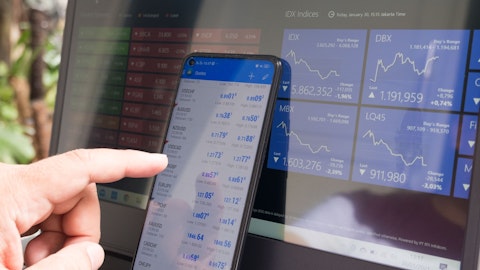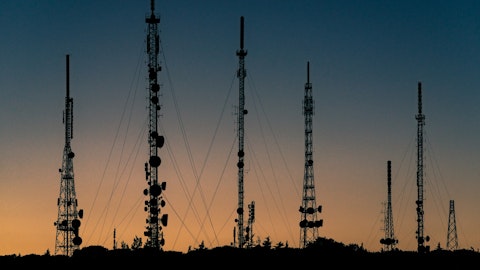Verizon Communications Inc. (NYSE:VZ) Q4 2022 Earnings Call Transcript January 24, 2023
Operator: Good morning, and welcome to the Verizon Fourth Quarter 2022 Earnings Conference Call. Today’s conference is being recorded. If you have any objections, you may disconnect at this time. It is now my pleasure to turn the call over to your host, Mr. Brady Connor, Senior Vice President, Investor Relations.
Brady Connor: Thanks, Brad. Good morning, and welcome to our fourth quarter earnings conference call. I’m Brady Connor, and I’m joined by our Chairman and Chief Executive Officer, Hans Vestberg; and Matt Ellis, our Chief Financial Officer. Before we begin, I’d like to draw your attention to our Safe Harbor statement, which can be found on Slide 2 of the presentation. Information in this presentation contains statements about expected future events and financial results that are forward-looking and subject to risks and uncertainties. Discussion of factors that may affect future results is contained in Verizon’s filings with the SEC, which are available on our website. This presentation contains certain non-GAAP financial measures.
Reconciliations of these non-GAAP measures to the most directly comparable GAAP measures are included in the financial materials posted on our website. Earlier this morning, we posted to our Investor Relations website, a detailed review of our fourth quarter and full year results. I hope you all had a chance to read the material. I’m going to briefly discuss the financial highlights before turning the call over to Hans to lead a discussion on our strategy, guidance and forward-looking view of the business. Slide 3 shows a summary of our results. Consolidated total operating revenue was $35.3 billion in the fourth quarter, up 3.5% year-over-year. Wireless service revenue grew 5.9% year-over-year in the fourth quarter benefiting from unlimited plan migrations, our best fourth quarter total postpaid net additions in seven years, pricing actions that we began implementing in June of 2022 and a full quarter contribution from TracFone.
Consolidated adjusted EBITDA was $11.7 billion for the fourth quarter, down 0.2% year-over-year. Wireless service revenue growth was offset by higher promotional expense, declines in our high-margin legacy wireline business and inflationary cost pressures. Adjusted earnings per share in the fourth quarter was $1.19, a decrease of 10.5% compared to the similar period in 2021, driven by higher interest expense, depreciation and lower pension-related income. Finally, we delivered $14.1 billion of free cash flow for the full year 2022 and exited the year with a net unsecured debt to adjusted EBITDA ratio of 2.7x. With that, I’ll now turn the call over to Hans.
Hans Vestberg: Thank you, Brady, and good morning, everyone. On today’s earnings call, I will focus on our strategy, guidance, expectation for the business and why I’m so excited about the opportunities for the year ahead. Let me start by saying that we deliver against all of our revised financial targets provided in July, including 8.6% wireless service revenue growth, $47.9 billion of adjusted EBITDA and adjusted earnings per share of $5.18. I’m pleased that the momentum built during the third quarter continued into the fourth quarter. Last quarter, we said expectation of a positive consumer phone net adds in the fourth quarter, and we delivered against that expectation. Although we have more work to do, I’m encouraged by the improvement and expect to build on the momentum in 2023.
The improvement in the consumer performance was complemented by yet another strong mobility quarter in Verizon Business Group as well as continued success in fixed wireless access with net adds up sequentially in both consumer and business. Together with FiOS result, we added 416,000 broadband subscribers in the quarter, our best total broadband performance in over a decade and approximately 1.3 million total broadband net adds for the year. Regarding our guidance, we have positioned ourselves to improve on our performance in 2023 and expect to build a good underlying operational momentum, although that will be offset by the impact of the noncash factors, such as promo amortization in our revenue growth and adjusted EBITDA. Additionally, we’re seeing some impact of high interest rates.
At the same time, we expect our capital spending to reduce significantly in 2023 as we reach the end of our incremental C-band spending, which will be a tailwind for free cash flow. We’re striving to make further improvement and take even more actions that will ultimately lead to better performance than the guidance we have outlined today. Matt will discuss the guidance in more detail later in the call. The industry entered 2023 with continued macroeconomic uncertainty as elevated inflation and interest rates impact the broader economy. Still, demand for our service remains strong, given the growing importance of mobility and broadband to both consumers and businesses. The combination of our network reliability, diverse portfolio of products and services and the industry’s strongest customer base provides us the flexibility to meet the changing customer needs even in a difficult economic environment.
We measure our success in maximizing value across stakeholders by our ability to grow service revenue, EBITDA and cash flow. Taking these three metrics together is how we hold ourselves accountable. We’re well positioned to improve our performance and accelerate growth on a go-forward basis with network quality as the foundation for our strategy and growth. We expect the wireless mobility and nationwide broadband will be the most significant contributor to Verizon’s growth for the next several years. In 2022, we made important progress in each of these businesses. Our growth in these areas will be driven by extending our network advantage using our C-band spectrum, which we expect will strengthen our network leadership in the coming years. We are taking a balanced approach on how we run our business, adding the right customers and generating ongoing profits from them is how we maximize value.
We remain focused on our cost reduction and efficiency actions, while also maximizing our return on invested capital via better monetizing our assets to put us on track to improve free cash flow going forward. We’re proud of being the strongest in the industry in terms of generating cash and want to preserve that while also continuing to strengthen our balance sheet. We’re executing with discipline and will continue driving a strategy which produces sustainable long-term growth and profitability. As connectivity plays an increasingly important role for consumers and businesses, it is the quality of the connectivity that matters the most. Not all networks are architected and built the same, nor have the same quality. We have seen these differences in the past and expect that 5G will be no different.
Our engineers have the best track record for designing and building networks that produce the best experience. Our network will continue to evolve with a relentless commitment to quality and reliability, adding capacity where needed and filling service gaps where they exist even as capital intensity declines in the coming years. In the shift to 5G, we have been rapidly building out our C-band spectrum with the most aggressive deployment plan in our company’s history. We are tracking to 200 million POPs this quarter and are well ahead of schedule to reach our 250 million POP targeted by year-end 2024. C-band propagation is very similar to that of AWS and PCS spectrum, which covers more than 300 million POPs today. This gives us a clear path to scale C-band quickly and efficiently, including in the 330 markets where we expect to gain complete access to the C-band spectrum later this year.
Due to the timing of spectrum availability, our deployment strategy targets the highest user areas first with the capability to deliver the most distinguished experience in places where the majority of our customers consume mobile services. As additional spectrum is cleared, we will have access to many new markets. As with prior generations of wireless technology, customers in all areas can expect to receive the best network experience. And where we have built out the C-band, we’re only getting started. Early deployments have limited to 60 megahertz or 100 megahertz in some early clearance markets. Consumer performance in this market has been encouraging as is evidenced by better retention, more favorable gross add trends and higher premium uptake.
In addition, the majority of our consumer fixed wireless net adds are on C-band. With the final trends of spectrum expected to be available in late 2023, we can deploy an average of 161 megahertz and up to 200 megahertz in certain markets across the entire Continental U.S. When we turn on the full breadth of spectrum, we expect peak download speeds to reach 2.4 gigabits per second, up from the 900 megabits per second we see with 60 megahertz deployed, all while supporting far more uses and applications. At the same time, we’re also deploying our 5G standalone core. So by the end of the year, you should see a network with incredible speeds, both downlink and uplink and position to deliver 5G capabilities such as network slicing, voice over 5G and/or among others.
We believe our network will allow us to maintain our premium position with our wireless mobility customers and provide reliable fixed wireless access services to consumers and businesses across the country. This is an example of how we can monetize our multipurpose network by scaling several revenue streams on the same infrastructure to enhance our return on investment. We’re adding far more capacity to our network than the peak usage increase were expected in fixed wireless markets. We continue to expect there will have 4 million to 5 million fixed subscribers by the end of 2025, and those subscribers will be enabled by our current build and capital plans. Our mobility and broadband plans are supported by our deep fiber position and ongoing fiber investments.
Approximately 50% of our sites are now served by our own fiber, up from 45% last year. We believe we are the only provider serving the level of its wireless network with its own fiber. This supports superior quality of services and end-to-end owners’ economics. That means better reliability and higher margins and look for us to continue to expand the percentage of sites on our own fiber. We also expanded our FiOS footprint by over 550,000 locations in 2022, extending our FiOS open for sales to more than 70 million locations. You can expect continued fiber expansion in the years ahead. In summary, network quality is the foundation of our strategy and growth. And all of the moves we are making are focused on ensuring we continue our network leadership in the future.

Photo by Brooke Cagle on Unsplash
As I mentioned earlier, Verizon’s success should be measured against three important metrics: service revenue, EBITDA and free cash flow. Let me now cover each of these in detail and tell you why I’m so confident in our ability to deliver against all three of these benchmarks. We expect that our network differentiation will be the cornerstone of our service revenue growth and that it will allow us to continue to attract the highest quality customer base in the industry and maintain our market-leading share of the B2B market. Our fixed wire access is also expected to contribute more meaningfully to service revenue as we enter the year growing rapidly with a base of more than 1.4 million subscribers. 2022 demonstrated to us that we need to be even more agile and responsive in the consumer market.
This is one of the reasons I assume leadership of the business late last year. We are moving into 2023 with momentum and expectation for improved performance based on recent actions and planned initiatives. After integrating TracFone over last year, we now have a full complement of offerings from entry-level prepaid all the way up to premium unlimited postpaid plans for the first time in our history. This will enable us to better attract new customers while also retaining customers through their mobile journey. You have already seen us take more segmented approach to the market through the Welcome Unlimited and One Unlimited plans in postpaid and the launch of Total by Verizon in prepaid. We’re already seeing the benefit from these actions.
In 2023, our plans will continue to evolve as we look for the best ways to cater to our customers, whether through network experience, content or other product offerings. Each new offering gives us an opportunity to engage with the prospective customers and ensure they receive a plan that best fits their needs. We remain disciplined around our core pricing and continue to perform well with our premium customers on retention and step-up activity. As we move into 2023, we’re taking a more localized approach with our network and go-to-market strategy, providing greater autonomy to the teams on the front line and speeding up the pace of decision-making. This will allow us to compete more effectively across geographies, particularly where dynamics may differ by individual market.
Finally, we continue to revise our sales compensation structure, ensuring we have the right incentives in place to drive sales growth. The customers we have and continue to attract represent the highest quality customer base in the industry. Based on our customer payment patterns, which are at or better than pre-pandemic levels, and the low delinquency rates in our securitized device payment plan portfolios, we continue to see only a limited impact from the macroeconomic environment on our customers. While we are watching this closely, we have a lot of confidence in the resilience of our customer base. Scaling of new business, such as private 5G networks and edge computing will also be a strategic focus in 2023. Our funnel is strong, and we’re making the appropriate investment to ensure such services provide a meaningful contribution to future growth in the years ahead, which differentiates us in the industry.
You can expect Verizon to compete, but I want to underline again that we will not sacrifice financial for volumes. We continue to focus on improving our cost of acquisition and retention and believe current promotion incentives are not sustainable for the industry in the long run. Although we have participated, to some extent, in this dynamic, expect us to pursue more ways to move away from the aggressive handset subsidies with offers like Welcome Unlimited plan, which offers attractive headline pricing for customers while reducing device subsidies. We manage the business for profitability and such actions drive healthy lifetime value for the business. Moving to Business Wireline. We’re taking several actions to reduce the financial impact of the unit and are scaling back on pursuing low margin revenue in order to gain drive improved profitability.
While this may result in missing out on revenue, it is a right move and one that will lead to higher margin and cash flow over time. At the same time, we are focused on further improving the cost structure through greater efficiencies. You may recall that we embarked on a new cost-cutting initiative late last year. The component of this initiative is the formation of Verizon Global Services. This organization is accelerating efforts to drive cross-functional efficiencies, enabling us to reinvest savings in network superiority and customer growth while contributing to long-term profitability. Additional opportunity exists in sourcing, sales and marketing and corporate system, among others. The heavy lifting is now underway as we execute against our goal to deliver $2 billion to $3 billion of run rate savings by 2025.
So our EBITDA strategy is clear. Grow profitable volumes in both consumer and business based on our increasingly differentiated network and manage our expenses the way you would expect us to do. By growing service revenue and EBITDA, we believe that we will be able to provide our shareholders with increasingly healthy free cash flow, which will support the strength of our balance sheet and fund our dividend growth. Our current streak of raising the dividend 16 years in a row is unmatched in the industry, and we intend to be able to continue that trend. Because our mobility and fixed water access products leverage the same infrastructure, they provide a capital-efficient path to future cash flow growth. We believe that we will become increasingly efficient with our capital, using less capital to generate every dollar of revenue for years to come.
That will enable us to produce expanding cash flow that we can both reinvest in our business and return to our shareholders. And as you know, we’re doing all of this as our capital spending budget is expected to decline from $23.1 billion in 2022 to under $19 billion at the midpoint of our guidance range this year, a reduction of nearly 20% year-over-year. In 2024, we expect our CapEx to be around $17 billion, which we expect to represent the lowest capital intensity in over a decade and among the lowest in the industry. We expect we will deliver a best-in-class network experience while reducing our 2022 CapEx leveraged by more than $5 billion over the next couple of years. With that, I turn it over to Matt to discuss guidance.
Matthew Ellis: Thank you, Hans, and good morning. I want to spend some time walking you through our 2023 guidance while also commenting on our longer-term outlook. Our 2023 guidance reflects momentum we have exiting 2022, which we expect to drive wireless service revenue growth. For 2023, we expect total wireless service revenue to grow between 2.5% and 4.5%, driven by increased penetration of premium unlimited plans, scaling of fixed wireless, continued growth in products and services, such as content and device protection plans and the full year impact of our pricing actions taken in 2022. As noted in our earnings materials, our wireless service revenue growth outlook includes an approximately 190 basis point benefit from a large allocation of our administrative and telco recovery fees, which partially recovered network operating costs to wireless service revenue from other revenue.
In addition, we expect promo amortization to be approximately $1 billion higher than last year. We expect adjusted EBITDA to be within a range of $47.0 billion to $48.5 billion. This outlook reflects expected higher wireless service revenue offset by wireline and other revenue declines and higher marketing and network operating expenses. Full year adjusted earnings per share is expected to be $4.55 to $4.85. As noted on our third quarter earnings call, high interest rates are expected to result in approximately $0.25 to $0.30 of interest expense pressure in 2023 due to higher floating rate debt costs and higher securitization costs for our growing device payment portfolio. We continue to believe we have the right debt structure for the long term and have managed the balance sheet appropriately by keeping short-term maturities to a minimum in this higher interest rate environment.
Higher rates of pension and OPEB, in addition to the lower pension asset base resulting from negative returns in 2022, are also expected to impact our adjusted EPS by approximately $0.12 to $0.15 compared to 2022. This flows through other income and expense on our income statement. Finally, we expect approximately $0.03 to $0.05 of impact from higher depreciation expense primarily driven by the C-band equipment being put into service across ’22 and into ’23. Our adjusted effective income tax rate is expected to be in the range of 22.5% to 24.0% based on current legislation. Capital spending for the full year is expected to be between $18.25 billion and $19.25 billion, including the final approximately $1.75 billion of the incremental $10 billion of C-band-related capital spending and we continue to expect total capital spending to be approximately $17 billion in 2024.
The reduction from the $23.1 billion CapEx in 2022 is expected to drive higher free cash flow in 2023 despite increases in cash interest and cash taxes. As previously discussed, we will complete our accelerated $10 billion C-Band program this year after which all C-band capital expenditures will be part of our business-as-usual capital program. Looking beyond 2023, given our exit rate from 2022 we don’t expect to hit the long-range outlook as we projected at the Investor Day last year. However, due to the way we have positioned our network and service offerings coming into 2023, we do expect increasing growth in revenue and cash flow in subsequent years. I will now turn it back over to Hans.
Hans Vestberg: Thank you, Matt. Let me summarize the Verizon opportunity in a few key points. We are making the necessary improvements to drive better performance. We have the best network, and it’s only getting better even as capital intensity improves. We have the largest EBITDA base in the industry and a clear path to free cash flow expansion. And finally, we have one of the most attractive dividends in the market and we intend to be able to continue the trend of growing the dividend each year. By that, I hand it over to Brady to start the Q&A.
Brady Connor: Thanks, Hans. Brad, we’re ready to take questions.
See also 12 Best Biofuel Stocks To Buy and 13 Largest Gold Mines in the World.
Q&A Session
Follow Verizon Communications Inc (NYSE:VZ)
Follow Verizon Communications Inc (NYSE:VZ)
Operator: Your first question comes from Simon Flannery of Morgan Stanley.
Simon Flannery : I had a couple of questions on the guidance. The first one is how are you thinking about your confidence and the visibility of this guide as compared to a year ago. Obviously, we had the war and stuff like that. But I think the reductions in guidance, obviously, were a concern for investors. So as you went through this process was the deliberate conservatism that you were trying to bake in to make sure that you could hit, and I think, Hans, you might have mentioned exceed the guidance with additional steps. So that kind of setup would be great. And then I guess for Matt, you called out some of the pressures on the bottom line, but you had a $0.30 range on your EPS guide. I think it was $0.15 a year ago. And it sounded like on the items you gave, the range wasn’t that wide. So perhaps you can just give us some color on what caused you to be as wide this year on the EPS?
Hans Vestberg : Thank you, Simon. I can start. I mean when it comes to the guidance, I mean, we — of course, it’s a little bit uncertain, as we said, coming into the year, but we’re laser focused on the service growth and on the EBITDA expansion and hence, also the cash flow expansion. And that’s how we are running our business, and that’s how we take decisions. And as I said, I mean, our job is, of course, to see that we are meeting or exceeding the guidance we’ve given out, and that’s how we’re going to work all the year. And our teams are set up to work like that. We are in the beginning of the year, so we’re going to see how it turns out. But clearly, we have a super laser-focused in the whole company, how we’re executing right now and how it hangs together.
And as I said before, we have now all the assets all the way from the network to our — to the prepaid to the postpaid, all that. And from us, it’s a lot of execution in a competitive market, but we definitely believe we can compete very well in that market. Matt?
Matthew Ellis : Thanks, Hans. Good morning, Simon. So look, as you think about the guide for the year, obviously, there’s a number of items in there, as I think about the range. We can get to the top end of the range there with strong execution, the activity around the cost program scaling, that flywheel moving faster than our base assumption. And just if we see more volumes come through the business there. Obviously, the low end will reflect the promo environment, the overall competitive environment and then we’ll save items like inflation and so on. So the range of the EPS guide, I think very similar to the EBITDA guide that we’ve given. And I think it reflects as we come into this year, when you think about some of the unknowns will play out here in the macro environment and the competitive environment, we feel it’s the right range to have for 2023. As Hans said, there’s a lot of things for us to stay focused on, and make sure we produce the best result possible.





